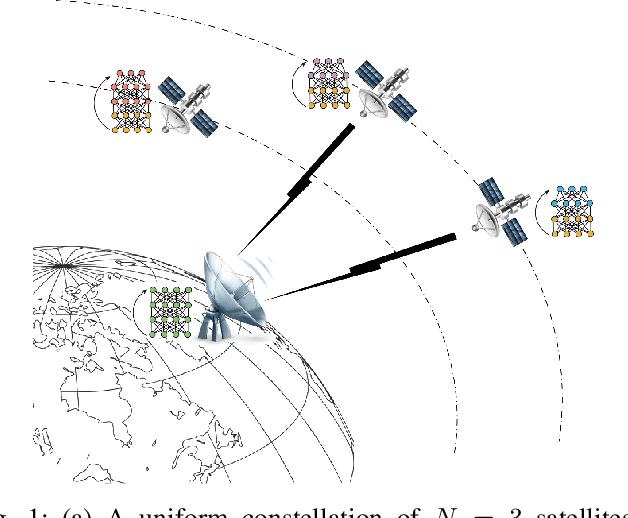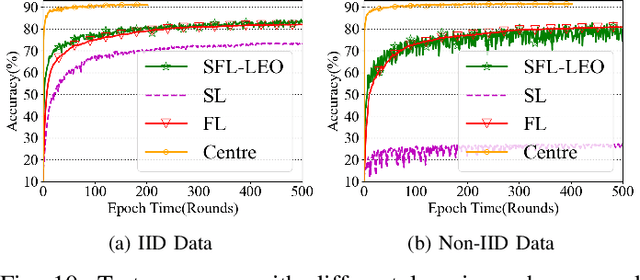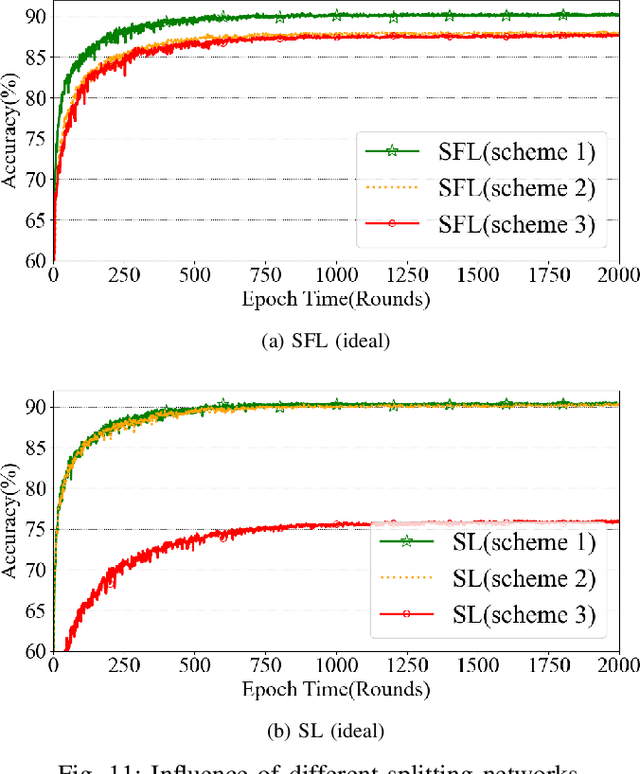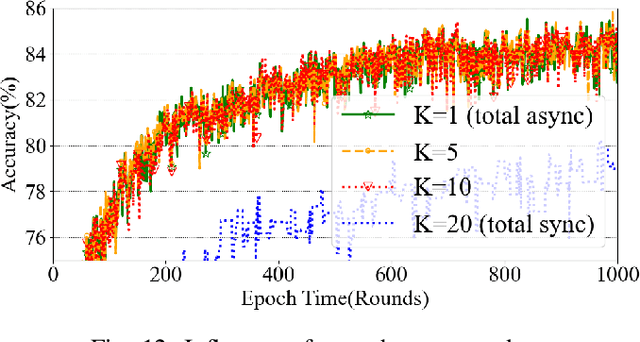Xiong Wang
B2LoRa: Boosting LoRa Transmission for Satellite-IoT Systems with Blind Coherent Combining
May 30, 2025Abstract:With the rapid growth of Low Earth Orbit (LEO) satellite networks, satellite-IoT systems using the LoRa technique have been increasingly deployed to provide widespread Internet services to low-power and low-cost ground devices. However, the long transmission distance and adverse environments from IoT satellites to ground devices pose a huge challenge to link reliability, as evidenced by the measurement results based on our real-world setup. In this paper, we propose a blind coherent combining design named B2LoRa to boost LoRa transmission performance. The intuition behind B2LoRa is to leverage the repeated broadcasting mechanism inherent in satellite-IoT systems to achieve coherent combining under the low-power and low-cost constraints, where each re-transmission at different times is regarded as the same packet transmitted from different antenna elements within an antenna array. Then, the problem is translated into aligning these packets at a fine granularity despite the time, frequency, and phase offsets between packets in the case of frequent packet loss. To overcome this challenge, we present three designs - joint packet sniffing, frequency shift alignment, and phase drift mitigation to deal with ultra-low SNRs and Doppler shifts featured in satellite-IoT systems, respectively. Finally, experiment results based on our real-world deployments demonstrate the high efficiency of B2LoRa.
SFL-LEO: Asynchronous Split-Federated Learning Design for LEO Satellite-Ground Network Framework
Apr 18, 2025



Abstract:Recently, the rapid development of LEO satellite networks spurs another widespread concern-data processing at satellites. However, achieving efficient computation at LEO satellites in highly dynamic satellite networks is challenging and remains an open problem when considering the constrained computation capability of LEO satellites. For the first time, we propose a novel distributed learning framework named SFL-LEO by combining Federated Learning (FL) with Split Learning (SL) to accommodate the high dynamics of LEO satellite networks and the constrained computation capability of LEO satellites by leveraging the periodical orbit traveling feature. The proposed scheme allows training locally by introducing an asynchronous training strategy, i.e., achieving local update when LEO satellites disconnect with the ground station, to provide much more training space and thus increase the training performance. Meanwhile, it aggregates client-side sub-models at the ground station and then distributes them to LEO satellites by borrowing the idea from the federated learning scheme. Experiment results driven by satellite-ground bandwidth measured in Starlink demonstrate that SFL-LEO provides a similar accuracy performance with the conventional SL scheme because it can perform local training even within the disconnection duration.
Qwen2.5-Omni Technical Report
Mar 26, 2025



Abstract:In this report, we present Qwen2.5-Omni, an end-to-end multimodal model designed to perceive diverse modalities, including text, images, audio, and video, while simultaneously generating text and natural speech responses in a streaming manner. To enable the streaming of multimodal information inputs, both audio and visual encoders utilize a block-wise processing approach. To synchronize the timestamps of video inputs with audio, we organize the audio and video sequentially in an interleaved manner and propose a novel position embedding approach, named TMRoPE(Time-aligned Multimodal RoPE). To concurrently generate text and speech while avoiding interference between the two modalities, we propose \textbf{Thinker-Talker} architecture. In this framework, Thinker functions as a large language model tasked with text generation, while Talker is a dual-track autoregressive model that directly utilizes the hidden representations from the Thinker to produce audio tokens as output. Both the Thinker and Talker models are designed to be trained and inferred in an end-to-end manner. For decoding audio tokens in a streaming manner, we introduce a sliding-window DiT that restricts the receptive field, aiming to reduce the initial package delay. Qwen2.5-Omni is comparable with the similarly sized Qwen2.5-VL and outperforms Qwen2-Audio. Furthermore, Qwen2.5-Omni achieves state-of-the-art performance on multimodal benchmarks like Omni-Bench. Notably, Qwen2.5-Omni's performance in end-to-end speech instruction following is comparable to its capabilities with text inputs, as evidenced by benchmarks such as MMLU and GSM8K. As for speech generation, Qwen2.5-Omni's streaming Talker outperforms most existing streaming and non-streaming alternatives in robustness and naturalness.
InSerter: Speech Instruction Following with Unsupervised Interleaved Pre-training
Mar 04, 2025



Abstract:Recent advancements in speech large language models (SpeechLLMs) have attracted considerable attention. Nonetheless, current methods exhibit suboptimal performance in adhering to speech instructions. Notably, the intelligence of models significantly diminishes when processing speech-form input as compared to direct text-form input. Prior work has attempted to mitigate this semantic inconsistency between speech and text representations through techniques such as representation and behavior alignment, which involve the meticulous design of data pairs during the post-training phase. In this paper, we introduce a simple and scalable training method called InSerter, which stands for Interleaved Speech-Text Representation Pre-training. InSerter is designed to pre-train large-scale unsupervised speech-text sequences, where the speech is synthesized from randomly selected segments of an extensive text corpus using text-to-speech conversion. Consequently, the model acquires the ability to generate textual continuations corresponding to the provided speech segments, obviating the need for intensive data design endeavors. To systematically evaluate speech instruction-following capabilities, we introduce SpeechInstructBench, the first comprehensive benchmark specifically designed for speech-oriented instruction-following tasks. Our proposed InSerter achieves SOTA performance in SpeechInstructBench and demonstrates superior or competitive results across diverse speech processing tasks.
Long-VITA: Scaling Large Multi-modal Models to 1 Million Tokens with Leading Short-Context Accuray
Feb 07, 2025Abstract:Establishing the long-context capability of large vision-language models is crucial for video understanding, high-resolution image understanding, multi-modal agents and reasoning. We introduce Long-VITA, a simple yet effective large multi-modal model for long-context visual-language understanding tasks. It is adept at concurrently processing and analyzing modalities of image, video, and text over 4K frames or 1M tokens while delivering advanced performances on short-context multi-modal tasks. We propose an effective multi-modal training schema that starts with large language models and proceeds through vision-language alignment, general knowledge learning, and two sequential stages of long-sequence fine-tuning. We further implement context-parallelism distributed inference and logits-masked language modeling head to scale Long-VITA to infinitely long inputs of images and texts during model inference. Regarding training data, Long-VITA is built on a mix of $17$M samples from public datasets only and demonstrates the state-of-the-art performance on various multi-modal benchmarks, compared against recent cutting-edge models with internal data. Long-VITA is fully reproducible and supports both NPU and GPU platforms for training and testing. We hope Long-VITA can serve as a competitive baseline and offer valuable insights for the open-source community in advancing long-context multi-modal understanding.
LUCY: Linguistic Understanding and Control Yielding Early Stage of Her
Jan 27, 2025



Abstract:The film Her features Samantha, a sophisticated AI audio agent who is capable of understanding both linguistic and paralinguistic information in human speech and delivering real-time responses that are natural, informative and sensitive to emotional subtleties. Moving one step toward more sophisticated audio agent from recent advancement in end-to-end (E2E) speech systems, we propose LUCY, a E2E speech model that (1) senses and responds to user's emotion, (2) deliver responses in a succinct and natural style, and (3) use external tool to answer real-time inquiries. Experiment results show that LUCY is better at emotion control than peer models, generating emotional responses based on linguistic emotional instructions and responding to paralinguistic emotional cues. Lucy is also able to generate responses in a more natural style, as judged by external language models, without sacrificing much performance on general question answering. Finally, LUCY can leverage function calls to answer questions that are out of its knowledge scope.
VITA-1.5: Towards GPT-4o Level Real-Time Vision and Speech Interaction
Jan 03, 2025



Abstract:Recent Multimodal Large Language Models (MLLMs) have typically focused on integrating visual and textual modalities, with less emphasis placed on the role of speech in enhancing interaction. However, speech plays a crucial role in multimodal dialogue systems, and implementing high-performance in both vision and speech tasks remains a significant challenge due to the fundamental modality differences. In this paper, we propose a carefully designed multi-stage training methodology that progressively trains LLM to understand both visual and speech information, ultimately enabling fluent vision and speech interaction. Our approach not only preserves strong vision-language capacity, but also enables efficient speech-to-speech dialogue capabilities without separate ASR and TTS modules, significantly accelerating multimodal end-to-end response speed. By comparing our method against state-of-the-art counterparts across benchmarks for image, video, and speech tasks, we demonstrate that our model is equipped with both strong visual and speech capabilities, making near real-time vision and speech interaction.
Freeze-Omni: A Smart and Low Latency Speech-to-speech Dialogue Model with Frozen LLM
Nov 01, 2024



Abstract:The rapid development of large language models has brought many new smart applications, especially the excellent multimodal human-computer interaction in GPT-4o has brought impressive experience to users. In this background, researchers have proposed many multimodal LLMs that can achieve speech-to-speech dialogue recently. In this paper, we propose a speech-text multimodal LLM architecture called Freeze-Omni. Our main contribution is the speech input and output modalities can connected to the LLM while keeping the LLM frozen throughout the training process. We designed 3-stage training strategies both for the modeling of speech input and output, enabling Freeze-Omni to obtain speech-to-speech dialogue ability using text-speech paired data (such as ASR and TTS data) and only 60,000 multi-round text Q&A data on 8 GPUs. Moreover, we can effectively ensure that the intelligence of the Freeze-Omni in the speech modality is at the same level compared with that in the text modality of its backbone LLM, while the end-to-end latency of the spoken response achieves a low level. In addition, we also designed a method to achieve duplex dialogue ability through multi-task training, making Freeze-Omni have a more natural style of dialogue ability between the users. Freeze-Omni mainly provides a possibility for researchers to conduct multimodal LLM under the condition of a frozen LLM, avoiding various impacts caused by the catastrophic forgetting of LLM caused by fewer data and training resources.
A Transcription Prompt-based Efficient Audio Large Language Model for Robust Speech Recognition
Aug 18, 2024Abstract:Audio-LLM introduces audio modality into a large language model (LLM) to enable a powerful LLM to recognize, understand, and generate audio. However, during speech recognition in noisy environments, we observed the presence of illusions and repetition issues in audio-LLM, leading to substitution and insertion errors. This paper proposes a transcription prompt-based audio-LLM by introducing an ASR expert as a transcription tokenizer and a hybrid Autoregressive (AR) Non-autoregressive (NAR) decoding approach to solve the above problems. Experiments on 10k-hour WenetSpeech Mandarin corpus show that our approach decreases 12.2% and 9.6% CER relatively on Test_Net and Test_Meeting evaluation sets compared with baseline. Notably, we reduce the decoding repetition rate on the evaluation set to zero, showing that the decoding repetition problem has been solved fundamentally.
VITA: Towards Open-Source Interactive Omni Multimodal LLM
Aug 09, 2024



Abstract:The remarkable multimodal capabilities and interactive experience of GPT-4o underscore their necessity in practical applications, yet open-source models rarely excel in both areas. In this paper, we introduce VITA, the first-ever open-source Multimodal Large Language Model (MLLM) adept at simultaneous processing and analysis of Video, Image, Text, and Audio modalities, and meanwhile has an advanced multimodal interactive experience. Starting from Mixtral 8x7B as a language foundation, we expand its Chinese vocabulary followed by bilingual instruction tuning. We further endow the language model with visual and audio capabilities through two-stage multi-task learning of multimodal alignment and instruction tuning. VITA demonstrates robust foundational capabilities of multilingual, vision, and audio understanding, as evidenced by its strong performance across a range of both unimodal and multimodal benchmarks. Beyond foundational capabilities, we have made considerable progress in enhancing the natural multimodal human-computer interaction experience. To the best of our knowledge, we are the first to exploit non-awakening interaction and audio interrupt in MLLM. VITA is the first step for the open-source community to explore the seamless integration of multimodal understanding and interaction. While there is still lots of work to be done on VITA to get close to close-source counterparts, we hope that its role as a pioneer can serve as a cornerstone for subsequent research. Project Page: https://vita-home.github.io.
 Add to Chrome
Add to Chrome Add to Firefox
Add to Firefox Add to Edge
Add to Edge